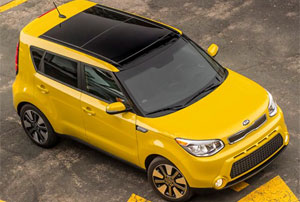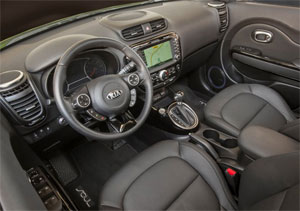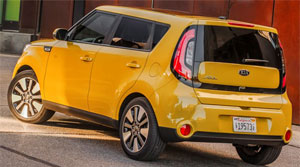2014 Kia Soul
Almost from the moment it arrived here for the 2010 model year, the Kia Soul became one of the brand’s top sellers. Its quirky design, low price, and the cute rodent advertising campaign, quickly made the Soul unforgettable. While aimed at the young, buyers from gen y to baby boomers were drawn to the Soul. Now, there is an all-new second generation Soul. So, let’s see if the 2014 Soul’s mass appeal is intact, or if it’s just grown up and out.
It seems like the Kia Soul has been around for a lot longer than just 4 years. You see them everywhere, no matter what social circle you travel in. But with the 2nd generation 2014 Soul, Kia is looking to see its social standing raised just a bit.
You see, despite originally being aimed at younger buyers, the Soul has proven very popular with mature drivers who found a “Soulmate” in Kia’s roomy bargain box on wheels.
On that point, the new Soul has a much more refined nature. To say the ride quality is greatly improved is an understatement. The chassis is stiffer, and a new subframe, mounted with impact absorbing bushings, and longer travel suspension, smooth things out exponentially.
 The MacPherson strut front suspension has been further revised by moving the stabilizer bar rearward and the steering box forward. An additional 8/10ths of an inch of wheelbase helps as well, though even after all of that, a minority of our drivers still found the ride to be “bumpy”. All agreed it has gotten much quieter inside and is now a fairly comfortable place to spend daily commute time.
The MacPherson strut front suspension has been further revised by moving the stabilizer bar rearward and the steering box forward. An additional 8/10ths of an inch of wheelbase helps as well, though even after all of that, a minority of our drivers still found the ride to be “bumpy”. All agreed it has gotten much quieter inside and is now a fairly comfortable place to spend daily commute time.
Engines choices are the same as before, but both have been tinkered with. The standard and already lethargic 1.6-liter actually rates less horsepower and torque than last year. The 2.0-liter in our Soul Exclaim adds direct injection for the same 164-horsepower but a small but welcomed boost in torque to 151 lb-ft.
Inside, we were very impressed with the upscale redesign. The bargain bling of the original has given way to a much more welcoming atmosphere. Mature drivers will like the new soft touch materials and the next gen. UVO infotainment system. Happily, Kia did keep a few of the Soul’s original youthful elements like the signature pulsating speaker lights.
But the most important change for all age groups is the improved seat comfort and overall roomier and more useful cabin. Cargo capacity is up to 24.2 cubic-ft. behind the folding rear seatbacks, 61.3 cubic-ft. with them flat.
 The decidedly upscale Sun and Sound option package adds a panoramic sunroof, Infinity audio system, Navigation with a large 8-inch touch screen display, and automatic temperature control. And the available Supervision instrument cluster features a 4.3-inch color LCD screen between the tach. and speedometer.
The decidedly upscale Sun and Sound option package adds a panoramic sunroof, Infinity audio system, Navigation with a large 8-inch touch screen display, and automatic temperature control. And the available Supervision instrument cluster features a 4.3-inch color LCD screen between the tach. and speedometer.
Push button start, heated and ventilated leather front seats, heated rear seats, and heated steering wheel are all offered as well.
Kia also wisely decided not to tinker too much with the Soul’s unique exterior styling, sticking with the same boxy bulldog shape as before, even though all sheet metal is new. It’s now more rounded, less squared off, and a tad more aggressive thanks to the larger openings up front and a wider stance.
LED positioning lights are standard on Exclaim model, but the HID headlights come as part of the “Whole Shebang Package”. Fenders are still very pronounced and the blacked-out A-pillars give a wraparound visor look to the greenhouse.
Exclaim trim also adds a halo treatment to the high mounted tail lights that lend a 70’s disco era sci-fi look.
Standard wheels are 16-inches, with the Exclaim riding on 18’s. But, you won’t exactly be spinning those wheels off the line too much, as power, even with the 2.0-liter, is adequate at best. Sprints to 60 take a sleepy 8.9–seconds.
The 1.6-liter Soul comes with a 6-speed manual, but a 6-speed automatic transmission is standard with the 2.0. Shifts were soft, and power slow to build on the way to a quarter mile time of 17.0-seconds and 84 miles-per-hour.
But once we started tackling the cones, we began to find some “soul”-ful fun. Despite the more refined ride of the new Soul, handling has also improved. Turn in is quick, and both under and over steer can be found if you go looking. Brake performance is also impressive with consistent stops from 60 averaging a short 118-feet.
 Government Fuel Economy Ratings are little changed. The 2.0-liter rates 23-City, 31-Highway, and 26-Combined. Fortunately even our lead footed drivers were able to achieve 26.8 miles-per-gallon of Regular in a mixed loop of driving. The Energy Impact Score is good at 12.7-barrels of yearly oil usage and 5.6-tons of CO2 emitted.
Government Fuel Economy Ratings are little changed. The 2.0-liter rates 23-City, 31-Highway, and 26-Combined. Fortunately even our lead footed drivers were able to achieve 26.8 miles-per-gallon of Regular in a mixed loop of driving. The Energy Impact Score is good at 12.7-barrels of yearly oil usage and 5.6-tons of CO2 emitted.
Even with prices sneaking up just a little, value continues to be a strong selling point; with base Souls starting at $15,695. Mid-level Plus models, at $19,195 and top-of-the-line Exclaims start at $21,295.
The Soul became an unqualified success in a single generation. And after some soul searching of our own, we conclude that the mostly very well executed updates will expand the 2014 Kia Soul’s mass appeal even more.
Specifications
- Engine: 2.0-liter
- Horsepower: 164
- Torque: 151 lb-ft.
- 0-60 mph: 8.9 seconds
- 1/4 mile: 17.0 seconds @ 84 mph
- EPA: 23 mpg city/ 31 mpg highway
- Energy Impact: 12.7 barrels of oil/yr
- CO2 Emissions: 5.6 tons/yr
2024 Toyota Land Cruiser
Toyota’s Go Anywhere Globetrotter Returns To U.S.
Every once in a while, we all need a reset. A time to get back to basics and prioritize the things that really matter. Well, for the Toyota Land Cruiser that time is now. So, let’s find out if that means bigger and better things for Toyota’s iconic off-roader.
The Toyota Land Cruiser’s status among the global off-road community is legendary, and it’s hard to imagine there’s any corner of the earth where a Land Cruiser hasn’t kicked up a little dust or mud. Well, 2024 sees the return of the Land Cruiser to the U.S. market after a 3-year hiatus, getting a major reset for the journey.
The reset comes mostly by no longer being based on the large three-row “300-series” chassis, but a new version of the smaller “200-series,” now known as the J250. As with the latest Tacoma, it uses the Tundra pickup’s full-size steel frame.
While the main Land Cruiser model, which goes by simply Land Cruiser, is packed full of luxury and convenience features, there is also a stripped-down model known as the 1958, honoring the first year the Land Cruiser made landfall here in North America. And it is that 1958 we have here, and we were glad to see it, as it also celebrates the original’s back-to-basics approach as a blank canvas for you to personalize as you tackle more and more adventures.
Not that it’s fully stripped down, as 8-inch touchscreen infotainment, a 7-inch full-color multi-information display, and automatic climate control are still standard. Plus, some seriously durable materials, and great heated cloth front seats that throw off some get serious 1990s Tacoma vibes.
But outside, there’s a definite lack of flashy trim and basic looking 18-inch wheels with Yokohama Geolander all-season tires; plus, big chunky bumpers and tilt-up back glass, which is a rarity that we appreciate. Though there is a little too much plastic in places that are sure to see some abuse if you do any significant off-roading.
It even feels a little rough around the edges, but for us it just adds to the rugged old-school utility vibe in a good way.
We did just that, both here in the Mid-Atlantic as well as in the California desert; and while there are some tech-forward driving aids, the actual hardware is in most cases plenty to get things done. That includes standard full-time dual-range four-wheel-drive, locking center and rear diffs, and 8.7-inches of ground clearance. A front stabilizer bar disconnect is also available to allow for increased articulation.
Who needs a V6 or even a V8 when you’ve got Toyota’s i-FORCE MAX setup at your disposal with 326 horsepower and 465 lb-ft of torque coming from a 2.4-liter turbo-four with an electric motor sandwiched between the engine and its eight-speed automatic transmission. Low speed torque delivery is impressive. It even feels a little rough around the edges, which may be a turn off to some, but for us it just adds to the rugged old-school utility vibe in a good way.
And it certainly feels quicker than an off roader needs to be, with an instant torque dump as soon as we eased on the throttle at our Mason Dixon test track; helping us get to 60 in 8.1 seconds and through the quarter-mile in 16.3 seconds at 86 mph. Considering the Land Cruiser’s terrain conquering mission, it behaved quite well in our handling course; it was plenty responsive to inputs, with less body roll than we expected and plenty of grip from the tires. The steering was light and quick but as expected didn’t provide much feel. Other than significant nosedive, braking performance was exceptional. Only 107-feet to panic stop us from 60 mph.
With the shift to the smaller size, there’s no more third row available, and cargo capacity now comes in at 46.2 cubic-feet with a max of a still healthy 82.1. Now, the best part of the Land Cruiser’s return is the entry price of $57,445. That’s about 30-grand less than what the last Land Cruiser went for back in 2021.
Whether it’s over the top fashion trends, mullets, or zombies; just when you think they’re dead, they come roaring back to life. Of course, we’re much happier to see the resurrection of this 2024 Toyota Land Cruiser than any of those things. Toyota is one brand that still recognizes the value of full-framed rugged rigs and has also acknowledged that sometimes less really is more. The Godfather of Toyota off-roading is back and better than ever.







